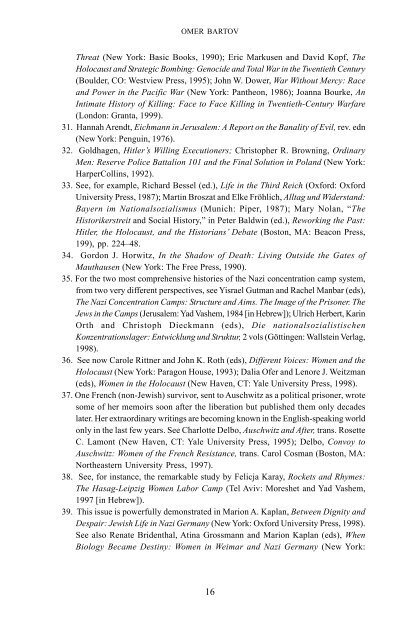The_Holokaust_-_origins,_implementation,_aftermath
The_Holokaust_-_origins,_implementation,_aftermath
The_Holokaust_-_origins,_implementation,_aftermath
You also want an ePaper? Increase the reach of your titles
YUMPU automatically turns print PDFs into web optimized ePapers that Google loves.
OMER BARTOV<br />
Threat (New York: Basic Books, 1990); Eric Markusen and David Kopf, <strong>The</strong><br />
Holocaust and Strategic Bombing: Genocide and Total War in the Twentieth Century<br />
(Boulder, CO: Westview Press, 1995); John W. Dower, War Without Mercy: Race<br />
and Power in the Pacific War (New York: Pantheon, 1986); Joanna Bourke, An<br />
Intimate History of Killing: Face to Face Killing in Twentieth-Century Warfare<br />
(London: Granta, 1999).<br />
31. Hannah Arendt, Eichmann in Jerusalem: A Report on the Banality of Evil, rev. edn<br />
(New York: Penguin, 1976).<br />
32. Goldhagen, Hitler’s Willing Executioners; Christopher R. Browning, Ordinary<br />
Men: Reserve Police Battalion 101 and the Final Solution in Poland (New York:<br />
HarperCollins, 1992).<br />
33. See, for example, Richard Bessel (ed.), Life in the Third Reich (Oxford: Oxford<br />
University Press, 1987); Martin Broszat and Elke Fröhlich, Alltag und Widerstand:<br />
Bayern im Nationalsozialismus (Munich: Piper, 1987); Mary Nolan, “<strong>The</strong><br />
Historikerstreit and Social History,” in Peter Baldwin (ed.), Reworking the Past:<br />
Hitler, the Holocaust, and the Historians’ Debate (Boston, MA: Beacon Press,<br />
199), pp. 224–48.<br />
34. Gordon J. Horwitz, In the Shadow of Death: Living Outside the Gates of<br />
Mauthausen (New York: <strong>The</strong> Free Press, 1990).<br />
35. For the two most comprehensive histories of the Nazi concentration camp system,<br />
from two very different perspectives, see Yisrael Gutman and Rachel Manbar (eds),<br />
<strong>The</strong> Nazi Concentration Camps: Structure and Aims. <strong>The</strong> Image of the Prisoner. <strong>The</strong><br />
Jews in the Camps (Jerusalem: Yad Vashem, 1984 [in Hebrew]); Ulrich Herbert, Karin<br />
Orth and Christoph Dieckmann (eds), Die nationalsozialistischen<br />
Konzentrationslager: Entwicklung und Struktur, 2 vols (Göttingen: Wallstein Verlag,<br />
1998).<br />
36. See now Carole Rittner and John K. Roth (eds), Different Voices: Women and the<br />
Holocaust (New York: Paragon House, 1993); Dalia Ofer and Lenore J. Weitzman<br />
(eds), Women in the Holocaust (New Haven, CT: Yale University Press, 1998).<br />
37. One French (non-Jewish) survivor, sent to Auschwitz as a political prisoner, wrote<br />
some of her memoirs soon after the liberation but published them only decades<br />
later. Her extraordinary writings are becoming known in the English-speaking world<br />
only in the last few years. See Charlotte Delbo, Auschwitz and After, trans. Rosette<br />
C. Lamont (New Haven, CT: Yale University Press, 1995); Delbo, Convoy to<br />
Auschwitz: Women of the French Resistance, trans. Carol Cosman (Boston, MA:<br />
Northeastern University Press, 1997).<br />
38. See, for instance, the remarkable study by Felicja Karay, Rockets and Rhymes:<br />
<strong>The</strong> Hasag-Leipzig Women Labor Camp (Tel Aviv: Moreshet and Yad Vashem,<br />
1997 [in Hebrew]).<br />
39. This issue is powerfully demonstrated in Marion A. Kaplan, Between Dignity and<br />
Despair: Jewish Life in Nazi Germany (New York: Oxford University Press, 1998).<br />
See also Renate Bridenthal, Atina Grossmann and Marion Kaplan (eds), When<br />
Biology Became Destiny: Women in Weimar and Nazi Germany (New York:<br />
16



